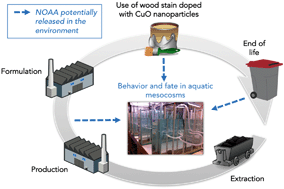Environmental exposure of a simulated pond ecosystem to a CuO nanoparticle-based wood stain throughout its life cycle†
Abstract
Indoor aquatic mesocosms were used to assess the behavior of fragmented products of a wood stain containing CuO nanoparticles in a simulated pond ecosystem for 1 month. By-products of degradation containing Cu are likely to be released during the use and end-of-life of this wood stain. Cu (bio)transformation and (bio)distribution within different environmental compartments (e.g. water, sediments, and benthic grazers) were carefully analyzed. Because of the presence of the stain matrix, CuO nanoparticles contained in fragmented products were less bio-physical–chemically transformed (dissolution, complexation) with respect to pristine nanoparticles. After 28 days, only 1% of the Cu injected following fragmented product exposure remained in the water column (0.08 μg L−1), and 10% for the pristine CuO nanoparticles (2.67 μg L−1). Among these ∼10%, ∼51% were dissolved Cu species (1.35 μg L−1). These results are discussed with respect to the ecological compartments in which they accumulated, and to the doses to which aquatic organisms with distinct life traits were exposed.



 Please wait while we load your content...
Please wait while we load your content...